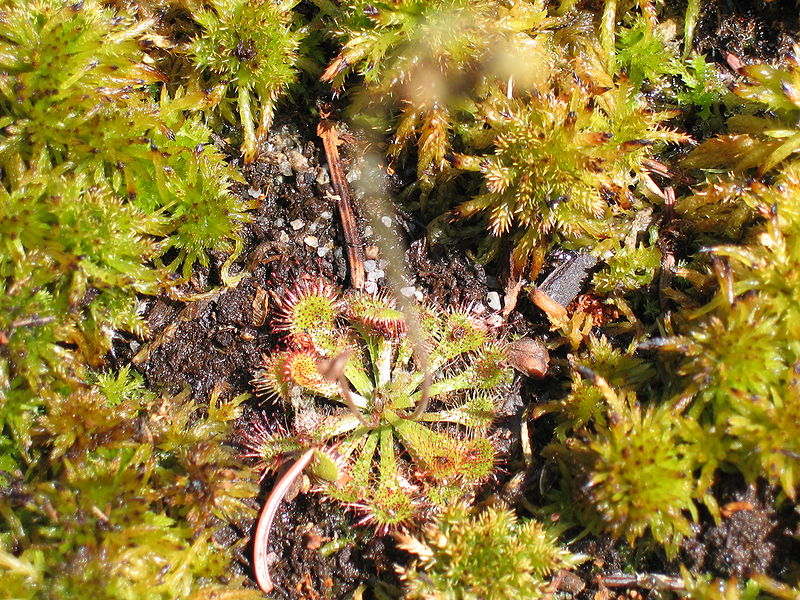It was found that in some areas there is competition for the same food between plants and spiders

But until today it was known and accepted that such a competition takes place between individuals of the same species - wolves belonging to different packs, between individuals of species belonging to the same genus - wolves versus jackals, and even between individuals of different types - tigers versus hyenas. The innovation is in the reality that individuals belonging to different kingdoms compete for the same food source.
In a field work conducted in South Florida and published in the Proceedings of the Royal Society B by David Jennings, it became clear that there is a competition for food between a wolf spider (predator) Alopecosa cuneata and a pink spider mite Drosera capillaris a carnivorous plant (previously a plant of the same type grew in the patient) growing in the environment damp
The talolith produces odorous substances that attract insects, when an innocent insect lands on the "talolith" leaf, the leaves fold and close the insect. Digestive juices are secreted and break down the insect into nutrients for the plant, meaning that the caterpillar is a "passive" hunter. The spider hunts (from an ambush) by jumping on its prey and immediately paralyzing it. That is, the spider is an active hunter.
Despite the differences in methods, despite the "Ionic" distance, there are areas where the spider and the spider live and hunt in the same habitats and the same insects.
It turned out that when there was a lack of food, the spiders built web traps to improve the hunter's chances, traps that were "at the expense" of the talisman plants since web traps reduced the number of insects in the field and prevented them from reaching the leaves of the plants. That is, when the conditions are difficult, the spiders themselves adapt and change the hunting method, an adaptation that harms the kills since the plant is not able to change the hunting method.
Wolf spiders are found in different habitats, tares grow only in moist habitats, it turns out that wolf spiders in moist conditions in places where tares grow are more inclined to build web traps, that is, they switch to a tolerant hunter and thus stand (perpetuated) in competition with the plants.
To verify the findings in the field, the researchers did an experiment in a controlled environment (laboratory), spiders were kept in containers into which insects were introduced, these were hunted by jumping from an ambush. When tall plants were placed in the containers... the spiders built web traps. In the next step, to see the effect on the plants, the containers (including mounds) were divided into those in which there was mostly food and spiders, little food without spiders, mostly food without spiders, little food and spiders, neither spiders nor food.
It turned out that the effect of the presence of spiders is noticeable and immediate.
The spiders in containers without food reacted the same as those in containers with little food and spiders: little flowering, slow growth and development, low reproductive capacity, that is: the presence of wolf spiders in a spider's environment... harms spiders, the researchers conclude: "Individuals from the plant kingdom compete (for food) with animals".

8 תגובות
As for the question, in light of the research it must be assumed that such competition is not unique,
But this is the first time that the competition and its effects have been identified and examined,
The emphasis of the researchers is on "competition between species from different kingdoms".
Asaf:
Without detracting from what is said in the article and from the pleasure and knowledge I derived from reading it, I find it appropriate to express the thought that this type of competition exists in all carnivorous plants.
After all, it is hard to assume that there are insects whose carnivorous plants are their only predator, and probably animals also compete for those insects - other insects or even mammals and birds.
Of course, the illustration in this case is particularly beautiful, but it should still be remembered that the reaction of the spiders, manifested in the deployment of webs, is probably not a direct response to the existence of webs, but to the lack of insects in general (and they would have acted this way even if the reason for the lack was different).
If my words are correct - then there is also an answer to Spatsikov's question.
Leder. Asaf Rosenthal
Are there more examples? It can't be the only one
L. A. Ben Ner
Carnivorous plants developed in poor soils (deficient in nutrients),
There is still a need for roots that provide water and "anchoring".
Nice research. The research topic is not a trivial thing, yet we will find who will research the topic (and who will write about it). Thanks for the article.
Leder. Asaf Rosenthal.
Do the pink Drosera capillaris (Drosera capillaris) plants also have soil roots?
Can they exist only from the roots or is the prey food necessary for their existence?
So in a moment of food crisis the plant will become extinct??
Unbelievable that such a small spider behaves like this.
An active hunter who knows how to completely change his attack habits.
Oppose the correlation between brain size and intelligence.